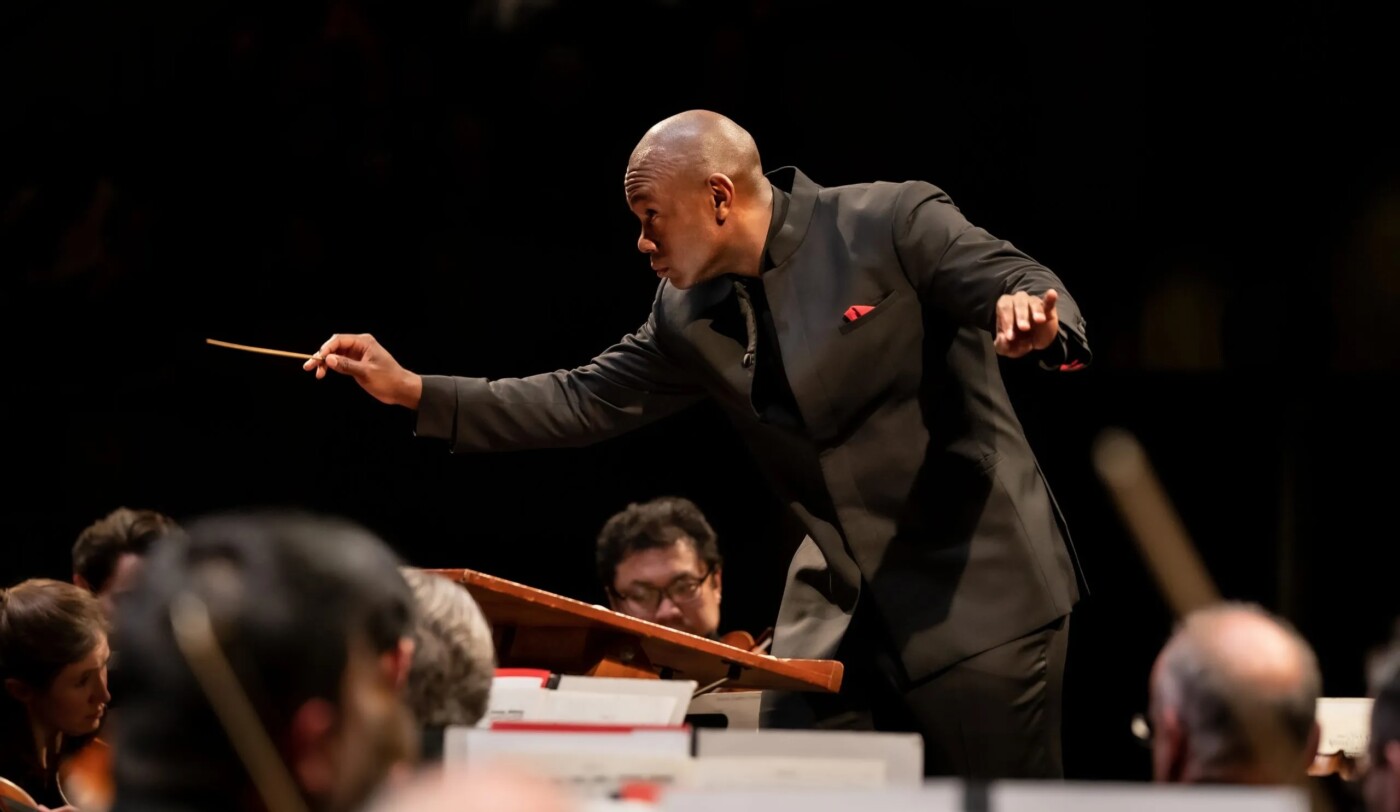Berkeley Symphony concludes its season June 1 in Zellerbach Hall with a concert called “Triumph” honoring music director Joseph Young, who is moving on to new opportunities after six years, and the announcement today of four guest conductors appearing in the 2025-26 season.
The June program includes the Bay Area premiere of Iranian-American composer Gity Razaz’s “Methuselah (In Chains of Time)”; Astor Piazzolla’s “Aconcagua” Concerto for Bandoneon, String Orchestra and Percussion featuring accordionist Hanzhi Wang, and Dmitri Shostakovich’s Symphony No. 5 in D minor.
Describing the music selection, Berkeley Symphony Executive Director Marion Atherton says, “Endurance is a common theme. Each piece highlights a life force that shows resilience and perseverance. It’s easy to get caught up in the problems of the here and now. This concert gives people a lift and perspective about larger concerns. It gives people hope and a vision for a positive future.”
Razaz’s work, a Berkeley Symphony co-commission with the League of American Orchestras and support from the Virginia B. Toulmin Foundation, is inspired by the ancient Great Basin bristlecone pine tree in the White Mountains in California’s Inyo County.
“It has gnarled and twisted roots and it’s 10,000 feet up a mountain,” Atherton says. “It doesn’t have a lot of rich soil or water in a difficult climate, so the music represents resilience,” Atherton adds, noting that the piece speaks to Young and orchestra’s mission to feature living composers and continue a “tradition and belief in music as a living art form and diversity and inclusion that value community.”
Wang, whom Atherton calls an “energetic, dynamic performer who brings emotional intelligence to her performances,” has a resume with notable firsts. She’s the only accordionist on the roster of Young Concert Artists, the New York management company representing the world’s most acclaimed classical musicians, and her CD “On the Path to H.C. Andersen” is Naxos label’s first solo accordion offering. A winner of multiple international competitions, she has degrees from the China Central Conservatory of Music in Beijing and the Royal Danish Academy of Music in Copenhagen.

Piazzolla’s concerto is written for the bandoneón, an Argentinian folk instrument used by tango musicians that lacks an accordion’s buttons but creates sound similarly through bellows. Wang’s virtuosity and Piazzolla’s orchestration elevates the instrument, enlarging the work while maintaining a playful, lively energy in the first and third movements, says Atherton, noting, “The second movement is more pensive. But that’s surrounded by playful, danceable music.”
Shostakovich’s Fifth Symphony, first performed in November 1937, was seen as a response with no words to criticism from Joseph Stalin and people suffering under his regime; it can be viewed as an early example of “speaking truth to power.”
Atherton says, “It begins virtuostically, the third movement is melancholy, almost like a requiem. The last movement is the celebratory, hopeful future. It goes from large and bombastic to more subtle, intimate music and really showcases the orchestra’s range.”
Offering both luxurious gentle moments and grand, dramatic sections, the program in particular shows off Wang, and the strings, brass and percussion sections.
Young will not be forgotten as the symphony moves forward.
Atherton says, “We’re sorry to see him go, but we’re excited to build on the legacy he’s leaving behind. Emphasizing American composers and with new works (presented) in proximity with traditional works will continue.”
The 2025-26 season, with concerts in Berkeley’s First Congregational Church, features: Dina Gilbert, conductor of Les Grands Ballets Canadiens in Quebec and cellist Gabriel Cabezas, playing Samy Moussa’s “Elysium”; Alyssa Weinberg’s “Caligo”; Tchaikovsky’s “Pezzo capriccioso” and Beethoven’s Third Symphony on Sept. 14, 2025; Edwin Outwater of the San Francisco Conservatory of Music conducting and violinist Helen Kim soloing in a program with Samuel Adams’ “Chamber Concerto”; Yaz Lancaster’s “Gender Envy” and Haydn’s Symphony No. 100 on Oct. 5, 2025; Ming Luke, Berkeley Symphony education conductor and San Francisco Ballet conductor, leading soprano Laquita Mitchell in a program with Juan Pablo Contreras’ “Alma Monarca”; Richard Strauss’ “Four Last Songs”; Missy Mazzoli’s “Sinfonia (for Orbiting Spheres)” and Shostakovich’s Symphony No. 9 on Nov. 16, 2025; and Carolyn Kuan, music director of the Hartford Symphony Orchestra and guitar soloist Marc Teicholz playing Huang Ruo’s “Folk Songs for orchestra”; Clarice Assad’s Concerto for Guitar and Chamber Orchestra and “O Saci-Pererê” and Dvořák’s Eighth Symphony on Jan. 25, 2026.
Berkeley Symphony’s “Triumph” is at 4 p.m. June in Zellerbach Hall, near Bancroft Way and Dana Street on the University of California, Berkeley campus. Tickets are $30 to $85 at www.berkeleysymphony.org.
The post Berkeley Symphony bids farewell to conductor Joseph Young, announces new season appeared first on Local News Matters.
